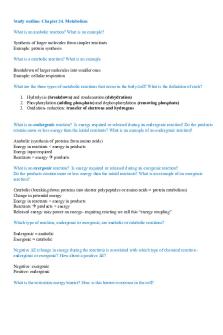24. Co Coast a case study PDF

| Title | 24. Co Coast a case study |
|---|---|
| Course | Advanced Marine Biology |
| Institution | Newcastle University |
| Pages | 3 |
| File Size | 75.9 KB |
| File Type | |
| Total Downloads | 23 |
| Total Views | 143 |
Summary
Download 24. Co Coast a case study PDF
Description
CoCoast: A case study Capturing our Coast – A unique interdisciplinary research project that explores the extent to which members of the public can contribute meaningfully to marine evidence gaps and address ecological hypotheses What was considered and why Independent species surveys Campaigns ‘Task C’ Scientific Hypothesis Testing and manipulative experiments Bioblitz ‘Species walls’ Varied in: -
The level of training needed The level of independence of activity The degree to which they needed to register or not
Choices made about project design -
Shifting Ranges of Species
8 species packages to choose from Each package is of 8 species Ensures critical mass of surveys per region and per species Criteria for species: -
Known climate change indicators Invasive species Common, keystone species whose abundance has disproportionate ecological effects Rare, patchily-occurring species
Species Package Surveys Why – to generate a baseline quantitative dataset of intertidal species around the UK coastline. One use of the data is to test the abundant centre hypothesis, investigating the relationship between species abundance and its position in its thermal range Motivations 1. 2. 3. 4. 5. 6.
Understanding Values Social Enhancement Protective Career
Types of data we collected Sargassum muticum -
Latitudinal trends and differences across UK regional seas Abundance of S. muticum in midshore pools Growth and reproductive cycles of S. muticum Macroalgal biodiversity in pools with/without S. muticum
-
Diversity and abundance of associated epibiota
Spermwatch -
Scientist urged public to look for lugworm sperm They explored: o Submission rates o Patterns of activity o Submission rates wrt demographics o Motivations and barriers of CoCoast registered vs non-registered
Way they aimed to support our volunteers Challenges of Citizen Science The problem – Recruiting citizen scientists and keeping them motivated to collect data and stay involved for the duration of the project The solution – A strategic, innovative, integrated communications strategy that responds to participant needs and motivations is vital for citizen science projects The volunteer experience – a multi-level volunteer engagement strategy to maximise and standardise the participant experience -
Multiple entry points for volunteers Key nationwide messaging Responsive to change Adapted to what worked and what did not Explored and utilised communication platforms and technology Strong training and support programme Frequent and personalised communications from hub Able to reach staff and gain support in multiple ways – email, web, phone, in the field, at events Weekday, weekend and evening activities National and regional communities
Incentivisation Participant groups – baseline survey 1. Volunteers trained but not surveyed 2. Volunteers who have completed 1-2 surveys 3. Super volunteers Discussion What is being done to boost participation? What could be done? What would incentivise people to do more? -
Regionally/nationally By activity type By audience type
Actions Simplification Targeted campaigns
Feedback strategy -
Feedback Fridays Newsletter features Infographics Blogs
Thanking participants The overall effect Generated feeling of belonging to a local project – close connection to a hub, face to face time with scientists Personal contact served to develop relationships and provide a ‘human face’ to science and research institutions Part of a “bigger picture” Multitude of opportunities to motivate participants – gamification, competition incentives Demonstrated to participants their contribution to wider project successes Successful regional media and publicity...
Similar Free PDFs

24. Co Coast a case study
- 3 Pages

Casestudy 76 - case study 24
- 6 Pages

Case Memo 1 Pepsi Co - Grade: A
- 3 Pages

ZIP CO Business Case
- 9 Pages

Trichotillomania: A Case Study
- 15 Pages

Sweet Leaf Bath Co(CASE)
- 15 Pages

Chapter 24 study guide
- 5 Pages

Case study Sears - Grade: A
- 3 Pages

RFID Case Study - Grade: A
- 8 Pages

Case study 1 - Grade: A
- 2 Pages

KFC Case study part A
- 8 Pages

A Case Study of Chandigarh
- 8 Pages

A Case Study on Bproperty
- 27 Pages
Popular Institutions
- Tinajero National High School - Annex
- Politeknik Caltex Riau
- Yokohama City University
- SGT University
- University of Al-Qadisiyah
- Divine Word College of Vigan
- Techniek College Rotterdam
- Universidade de Santiago
- Universiti Teknologi MARA Cawangan Johor Kampus Pasir Gudang
- Poltekkes Kemenkes Yogyakarta
- Baguio City National High School
- Colegio san marcos
- preparatoria uno
- Centro de Bachillerato Tecnológico Industrial y de Servicios No. 107
- Dalian Maritime University
- Quang Trung Secondary School
- Colegio Tecnológico en Informática
- Corporación Regional de Educación Superior
- Grupo CEDVA
- Dar Al Uloom University
- Centro de Estudios Preuniversitarios de la Universidad Nacional de Ingeniería
- 上智大学
- Aakash International School, Nuna Majara
- San Felipe Neri Catholic School
- Kang Chiao International School - New Taipei City
- Misamis Occidental National High School
- Institución Educativa Escuela Normal Juan Ladrilleros
- Kolehiyo ng Pantukan
- Batanes State College
- Instituto Continental
- Sekolah Menengah Kejuruan Kesehatan Kaltara (Tarakan)
- Colegio de La Inmaculada Concepcion - Cebu


